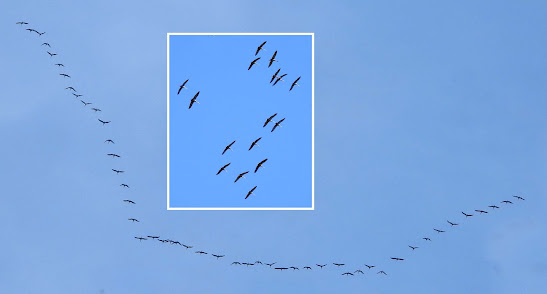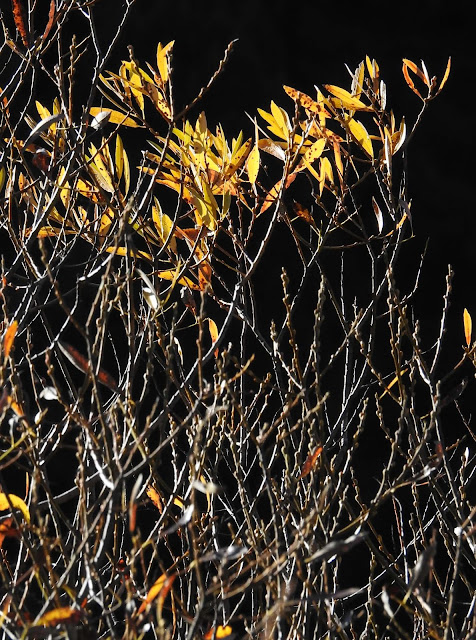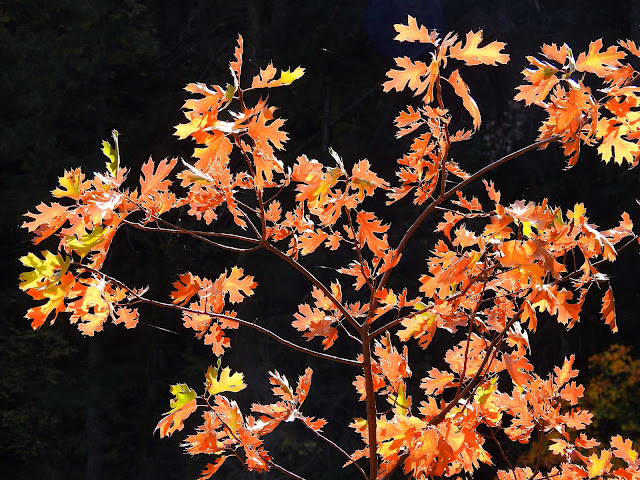Steller's Jay (adult) - Cyanocitta stelleri
It's definitely Fall in my neighborhood! The long distance migratory birds are mostly on their way south to their winter residences, and the local year-round birds are dominating the neighborhood once again!
I don't usually talk much about the birds that live here all year, as I'm always distracted by the tropical migrants. They are just as lovely and wonderful as the tropical birds, but even more amazing because of their ability to over-winter in our snowy climate!
Unfortunately, because I see them so often, I tend to take Steller's Jays for granted. However, they are anything but "common". They are super smart and inquisitive. They watch everything that's going on in our neighborhood, to raise an alarm if necessary, but more often to see an opportunity for some food. I once watched a squirrel bury a walnut, and within one minute after the squirrel left, a Steller's Jay unearthed the walnut and flew away with it!!! They have habituated readily to humans, and are regular scavengers in residential areas, campgrounds and picnic areas. They are excellent vocal mimics, like Ravens, and easily imitate the sounds and calls made by other birds, dogs, cats, squirrels, as well as environmental and man made noises!
Steller's Jays mate for life. They are omnivores and eat carrion, small mammals, bird eggs, baby birds, insects, reptiles, acorns, berries, seeds, and garbage. Their beautiful blue feathers can vary in hue from turquoise to royal blue. The color comes from the cell structure of the feathers, not from pigment!
Black Phoebe (adult) - Sayornis nigricans
Black Phoebes are typically non-social and solitary, except during breeding season. They are flycatchers, and feed by flying out from a perch and catching flying insects, or "hawking". Their diet consists of variety of insects, spiders, small fish, as well as fruits and berries in winter. They prefer to live near water. They are year-round residents in our neighborhood, and do not migrate.
Common Raven (adult) - Corvus corax
Of all the corvids, Ravens may be the smartest! They are capable of learning innovative solutions to newly encountered problems! They are also the biggest of all perching birds! Ravens can be found in almost any location across the globe! However, Ravens are non-migratory, and remain all year in their chosen location. We have a pair of Common Ravens that have lived in our neighborhood for years! I just love hearing them call to each other!
Ravens are omnivorous, and eat carrion, small mammals, baby birds, bird eggs, insects, acorns, grains, fish, and even garbage! They are also known to store extra food in secret hiding places! They will often feed together in large groups, but live singly or in mated pairs.
Of all the corvids, Ravens are the most playful! They have been seen playing games, like dropping a stick in the air and catching it before it lands! Ravens also like to swing upside down, do rolls and somersaults in the air, and slide down snow banks! Scientists think this play may be just for fun, or perhaps a way of showing off and attracting a mate.
Sandhill Cranes - Antigone canadensis
To my delight I saw and heard a group of 49 Sandhill Cranes flying over our neighborhood this week!!! They were heading to California's Central Valley where they will over-winter. Most of the Sandhill Cranes that overwinter in California's Central Valley breed in Idaho and Oregon. I am so glad that they flew by! They are one of my absolute favorite signs of Fall!
Bald Eagle (adult) - Haliaeetus leucocephalus
To our complete surprise there was a Bald Eagle on the river this week! We only saw it once. They are uncommon in our area, and it's a rare privilege to see one! WOW!!! Bald Eagles are LARGE birds, measuring 31" in height, with a wingspan of 80" (6.5 feet!)!! Fish, waterfowl, and mammals are their main prey.
The American Eagle Foundation states: "Bald Eagles were once very common throughout most of the United States. Their population numbers have been estimated at 300,000 to 500,000 birds in the early 1700s. Their population fell to threatened levels in the continental U.S. of less than 10,000 nesting pairs by the 1950s, and to endangered levels of less than 500 pairs by the early 1960s. This population decline was caused by humans. The mass shooting of eagles, use of pesticides on crops, destruction of habitat, and contamination of waterways and food sources by a wide range of poisons and pollutants all played a role in harming the Bald Eagle's livelihood and diminishing their numbers. For many years the use of DDT pesticide on crops caused thinning of eagle egg shells, which often broke during incubation.Strong endangered species and environmental protection laws, as well as active private, state and federal conservation efforts, have brought back the U.S.A.'s Bald Eagle population from the edge of extinction. The use of DDT pesticide is now outlawed in the U.S. This action has contributed greatly to the return of the Bald Eagle to America's skies. The Bald Eagle is presently protected by the Endangered Species Act of 1973, Bald Eagle Protection Act of 1940, Migratory Bird Treaty Act of 1918, and the Lacey Act. It is listed as a "threatened" species in the lower 48 states."
Currently there is approximately 10,000 breeding pairs in mainland U.S. and approximately 35,000 breeding pairs in Alaska. It is my sincere hope that they remain protected by laws, and that their population continues to thrive. How lucky we were to see one these magnificent eagles!
Belted Kingfisher (female) - Megaceryle Halcyon
Unlike most birds, the female Kingfisher is more colorful than the male. The male does not have the rust-colored band across its chest, nor patches underneath its wings. Kingfishers catch small fish, crayfish, and tadpoles by plunge-diving from perches, into shallow or surface water. Most of their dives are less than 24" deep into the water. After they catch their prey, they bring it back to a perch and pound it against a branch to stun it! Whatever they cannot digest, such as fish bones etc, is regurgitated in pellets!
Spotted Towhee (male) - Pipilo maculatus
Spotted Towhees are year-round residents in our neighborhood. In spring and summer they mainly eat insects, as well as some plants. In fall and winter their diet consist of mainly seeds, especially sunflower-family plants and thistles. Right now they are taking advantage of the multitude of sunflower seeds in our garden! Every morning I see them looking for food on the ground, pecking and scratch/hopping backwards!
I've been seeing several coveys of 6-9 Mountain Quail in our neighborhood this week. These beautiful birds are way more visible on the white snow than they are in the summer! They are the largest North American quail, measuring 11" in height, with a wingspan of 16", and a weight of 8 oz. Every spring they walk as much as 20 miles up to their breeding/nesting grounds at higher elevations. In the fall they walk back to down to lower elevations to spend the winter. They eat a large variety of plants and seeds. In the fall and winter they stay together in small coveys of family related groups, while foraging and roosting.
Black Locust - Robinia pseudoacacia
The Deciduous Trees!
The local deciduous trees have changed the whole landscape with their gorgeous Fall colors! The willow, locust, cherry, and maple trees are all turning brilliant butter-yellow, the dogwoods are bright raspberry-jam in color, and the black oaks are just starting to change to a golden-yellow. Here's a few photos! Enjoy!
Big Leaf Maple & Mountain Dogwood
Robinia pseudoacacia - Cornus nuttallii
Willow - Salix sp.
California Black Oak - Quercus kelloggi
California Black Oak - Quercus kelloggi
Morning Mist after the .37" of rain!
Have any mushrooms popped up?
What's happening in the Lakes Basin?
Check back next week for the answers to these questions and more!
Your questions and comments are greatly appreciated!
Please email me at northyubanaturalist@gmail.com.




.JPG)

.jpg)







No comments:
Post a Comment